IBM Research: Stochastic Phase-Change Neurons
Created randomly spiking neurons using phase-change materials to store and process data.
This is a Press Release edited by StorageNewsletter.com on August 4, 2016 at 1:03 pmIBM Corp.’s scientists from Zurich Labs., Switzerland, imitate the functionality of neurons with a phase-change device technology could lead to the development of neuromorphic computers with highly co-located memory and processing units to speed up cognitive computing and analyze IoT big data.
Stochastic phase-change neurons
An artistic rendering of a population of
stochastic phase-change neurons
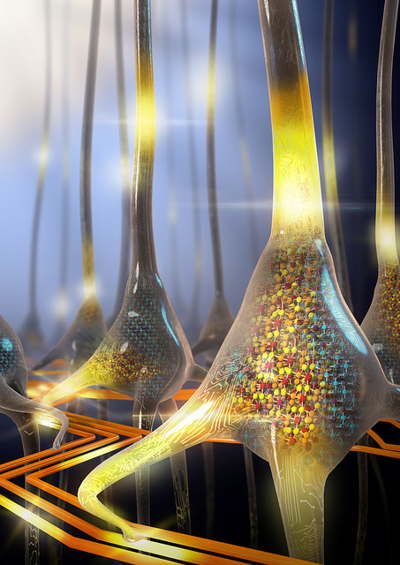
For the first time, IBM scientists have created randomly spiking neurons using phase-change materials to store and process data. This demonstration marks a significant step forward in the development of energy-efficient, ultra-dense integrated neuromorphic technologies for applications in cognitive computing.
Inspired by the way the biological brain functions, scientists have theorized for decades that it should be possible to imitate the versatile computational capabilities of large populations of neurons. However, doing so at densities and with a power budget that would be comparable to those seen in biology has been a significant challenge, until now.
“We have been researching phase-change materials for memory applications for over a decade, and our progress in the past 24 months has been remarkable,” said Evangelos Eleftheriou, IBM fellow. “In this period, we have discovered and published new memory techniques, including projected memory, stored 3bits per cell in phase-change memory for the first time, and now are demonstrating the powerful capabilities of phase-change-based artificial neurons, which can perform various computational primitives such as data-correlation detection and unsupervised learning at high speeds using very little energy.“
Artificial neuron based on a phase-change device, with an array of plastic synapses at its input. Schematic of an artificial neuron that consists of the input (dendrites), the soma (which comprises the neuronal membrane and the spike event generation mechanism) and the output (axon). The dendrites may be connected to plastic synapses interfacing the neuron with other neurons in a network. The key computational element is the neuronal membrane, which stores the membrane potential in the phase configuration of a nanoscale phase-change device. Owing to their inherent nanosecond-timescale dynamics, nanometre-length-scale dimensions and native stochasticity, these devices enable the emulation of large and dense populations of neurons for bioinspired signal representation and computation.
Click to enlarge
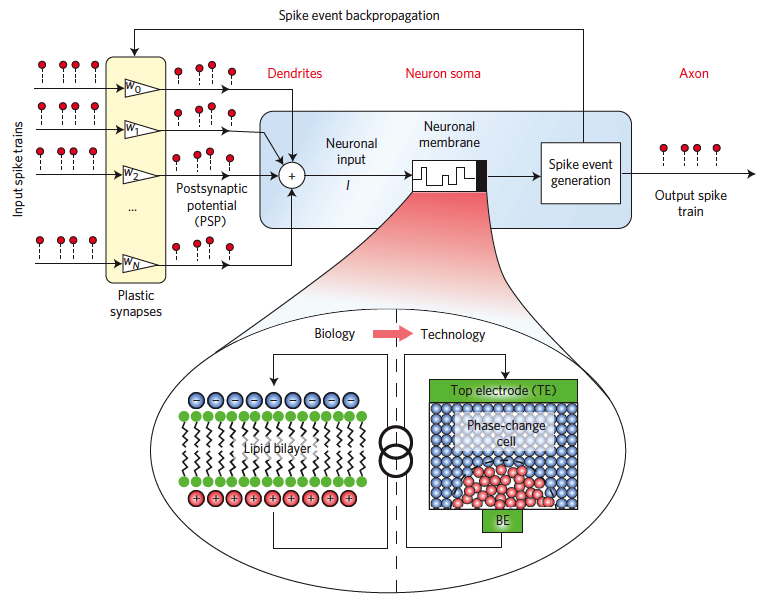 The results of this research are appearing on the cover of the peer-reviewed journal Nature Nanotechnology.
The results of this research are appearing on the cover of the peer-reviewed journal Nature Nanotechnology.
From left to right, Abu Sebastian, Evangelos Eleftheriou Tomas Tuma,
Angeliki Pantai and Manuel Le Gallo co-authored a paper
in Nature Nanotechnology titled Stochastic phase-change neurons.
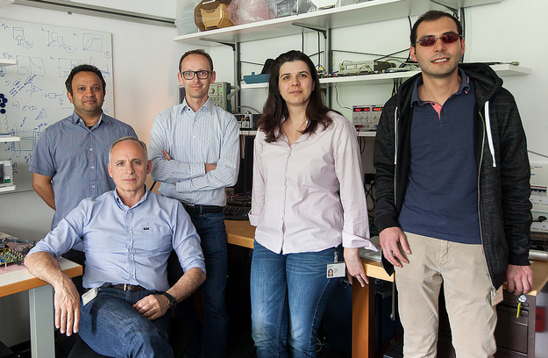
The artificial neurons designed by IBM scientists in Zurich, Switzerland, consist of phase-change materials, including germanium antimony telluride, which exhibit two stable states, an amorphous one (without a clearly defined structure) and a crystalline one (with structure). These materials are the basis of re-writable Blu-ray discs. However, the artificial neurons do not store digital information; they are analog, just like the synapses and neurons in our biological brain. In the published demonstration, the team applied a series of electrical pulses to the artificial neurons, which resulted in the progressive crystallization of the phase-change material, ultimately causing the neuron to fire. In neuroscience, this function is known as the integrate-and-fire property of biological neurons. This is the foundation for event-based computation and, in principle, is similar to how our brain triggers a response when we touch something hot.
Phase-change neurons. A chip with large arrays of phase-change devices that store the state of artificial neuronal populations in their atomic configuration. In the photograph, individual devices are accessed by means of an array of probes to allow for precise characterization, modeling and interrogation. The tiny squares are contact pads that are used to access the nanometer-scale phase-change cells (not visible). The sharp probes touch the contact pads to change the phase configuration stored in the cells in response to the neuronal input. Each set of probes can access a population of 100 cells. The chip hosts only the phase-change devices that are the ‘heart’ of the neurons. There are thousands to millions of these cells on one chip and we access them (in this particular photograph) by means of the sharp needles (probe card).
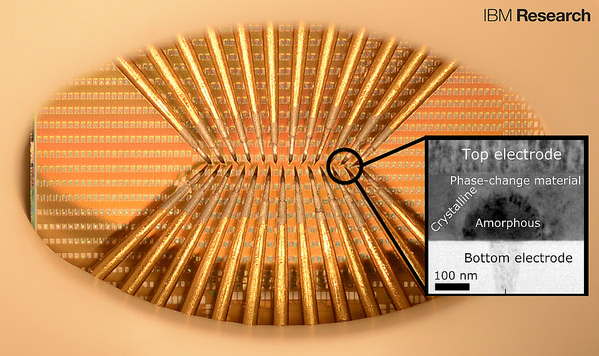
Exploiting this integrate-and-fire property, even a single neuron can be used to detect patterns and discover correlations in real-time streams of event-based data. For example, in the IoT, sensors can collect and analyze volumes of weather data collected at the edge for faster forecasts. The artificial neurons could also detect patterns in financial transactions to find discrepancies or use data from social media to discover new cultural trends in real time. Large populations of these high-speed, low-energy nano-scale neurons could also be used in neuromorphic coprocessors with co-located memory and processing units. IBM scientists have organized hundreds of artificial neurons into populations and used them to represent fast and complex signals. Moreover, the artificial neurons have been shown to sustain billions of switching cycles, which would correspond to multiple years of operation at an update frequency of 100 Hz. The energy required for each neuron update was less than five picojoule and the average power less than 120 microwatts – for comparison, 60 million microwatts power a 60 watt lightbulb.
Tomas Tuma, IBM
“Populations of stochastic phase-change neurons, combined with other nanoscale computational elements such as artificial synapses, could be a key enabler for the creation of a new generation of extremely dense neuromorphic computing systems,” said Tomas Tuma, a co-author of the paper.
Article:
Nature Nanotechnology has published in article written by Tomas Tuma, Angeliki Pantazi, IBM Research-Zurich, CH-8803 Rüschlikon, Switzerland, Manuel Le Gallo, IBM Research-Zurich, CH-8803 Rüschlikon, Switzerland, and ETH Zurich, CH-8092 Zurich, Switzerland, Abu Sebastian, and Evangelos Eleftheriou, IBM Research-Zurich, CH-8803 Rüschlikon, Switzerland.
Abstract: “Artificial neuromorphic systems based on populations of spiking neurons are an indispensable tool in understanding the human brain and in constructing neuromimetic computational systems. To reach areal and power efficiencies comparable to those seen in biological systems, electroionics-based and phase-change-based memristive devices have been explored as nanoscale counterparts of synapses. However, progress on scalable realizations of neurons has so far been limited. Here, we show that chalcogenide-based phase-change materials can be used to create an artificial neuron in which the membrane potential is represented by the phase configuration of the nanoscale phase-change device. By exploiting the physics of reversible amorphous-to-crystal phase transitions, we show that the temporal integration of postsynaptic potentials can be achieved on a nanosecond timescale. Moreover, we show that this is inherently stochastic because of the melt-quench-induced reconfiguration of the atomic structure occurring when the neuron is reset. We demonstrate the use of these phase-change neurons, and their populations, in the detection of temporal correlations in parallel data streams and in sub-Nyquist representation of high-bandwidth signals.”








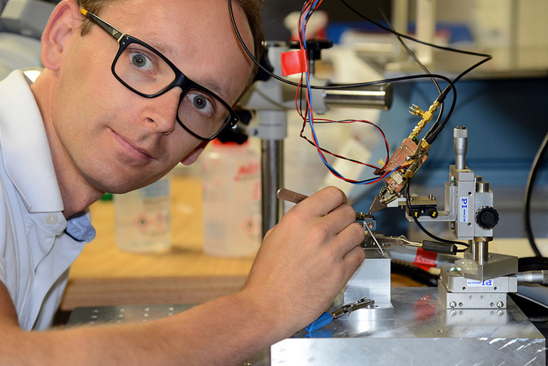




 Subscribe to our free daily newsletter
Subscribe to our free daily newsletter
